TAKEAWAY: You can add another great piece to the growing list of excellent multimedia storytelling examples. This time, it is The Guardian’s turn to give us a timely, highly readable story with visuals that enhance the content at every step.
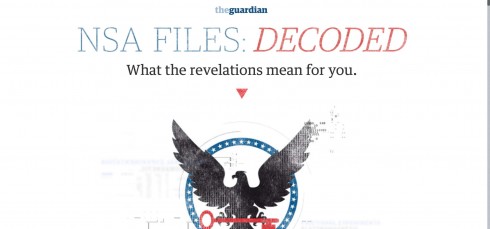
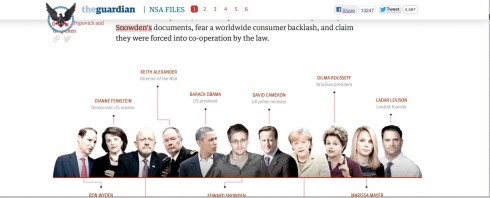
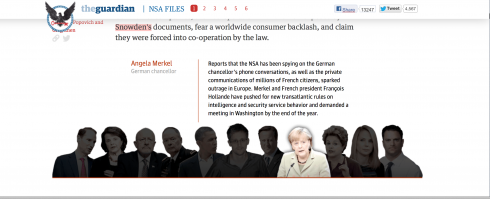
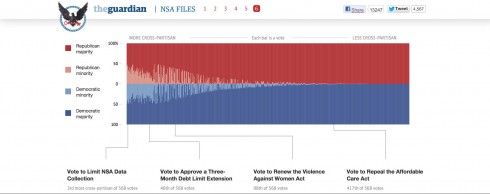
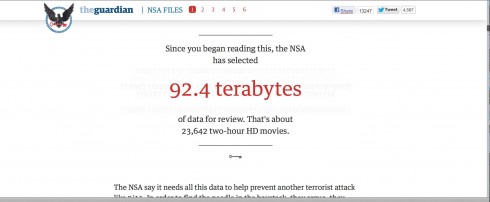

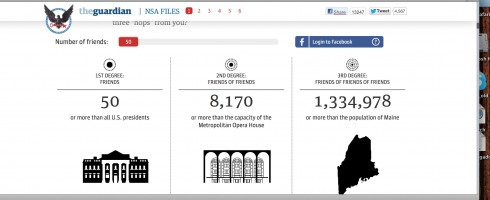
Screen shots from The Guardian’s latest multimedia story:NSA Files: Decoded—What the revelations mean for you
Go here to read the story: http://www.theguardian.com/world/interactive/2013/nov/01/snowden-nsa-files-surveillance-revelations-decoded#section/1
The Guardian surprises us with another excellent example of multimedia storytelling. This time, The Guardian picks up a timely story which they partly own and which most likely will end up as one of the top 10 stories of 2013. Titled NSA Files: Decoded—What the revelations mean for you, this story has the look and feel of an enterprise, interpretive piece. There are no visual frills, only visual enhancements to the story, mostly through the use of videos in which a variety of expert sources discuss the impact that whistleblower Edward Snowden’s revelations had on the US and its relations with its global partners.
In fact, in one of the most interesting visuals of the story, one can roll the mouse over the image of a variety of personalities and find out the role each plays in the story.
But, in my view, what separates this story from other recent examples, is not just the topic—-which is more difficult to present well in a multimedia storytelling package than, let’s say, the visuals of Snow Fall or Tomato Can Blues, for example. Here the story is serious, and, one may add, based on a dry subject.
Where could the designers go to get their visual inspiration? They did not fool themselves or the audience.
We have “head shots”, as plain and simple as that. But these are “talking head shots”, nothing too exciting, but a great way to get us engaged with the story before we read a word.
Functionality is the key, and there are those constant reminders that you are engaged with digital presentation of news, as when one sees a constantly changing number, under the heading:
Since you began reading this, the NSA has selected 99.6 terabytes of data for review. That’s about 25,485 two hour HD movies.
Nice touch, I might add. For the “always connected” generation, that moving clock is better than pie a la mode.
The Guardian’s Interactive Editor Gabriel Dance: “This is non-replicable in print”
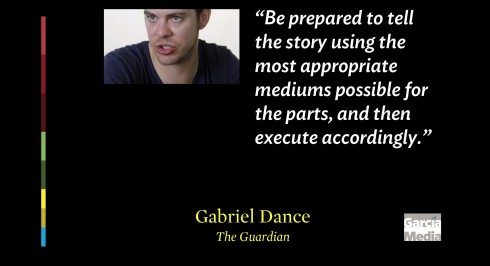
Gabriel Dance, The Guardian’s interactive editor and one of the writers involved in The Guardian’s NSA piece, tells me something that is what I try to emphasize in my multimedia storytelling workshops: from the start the story is seen as a digital piece.
This project is web-native like few others I’ve seen from news outlets, especially those with print products. We created something that is simply non-replicable in print. But totally appropriate to the story we were trying to tell.
To me, this is at the heart of the success of this particular story and how storytelling is enhanced through a variety of techniques. Not easy to accomplish, and even more difficult when it comes to convincing editors and writers. For Gabriel, this is part of what he trained to do:
I went to graduate school at the University of North Carolina, Chapel Hill. While I was there, a large part of our focus was on telling the story with the most appropriate medium possible. The NSA Files Decoded project is for me the closest I’ve come to fulfilling that vision. For the project, we tried to use the most compelling, appropriate storytelling method for the narrative. So instead of simply quoting an expert, we allowed them to speak directly to the user. Instead of simply giving one example of ‘3 hops’ from a specific number, we allow the user to connect with Facebook or adjust the interactive to personalize the story. We use gifs, video, interactives and copy in a completely medium-agnostic manner, allowing the narrative to essentially tell itself.
A chat with Bob Sacha: who shot video for the story
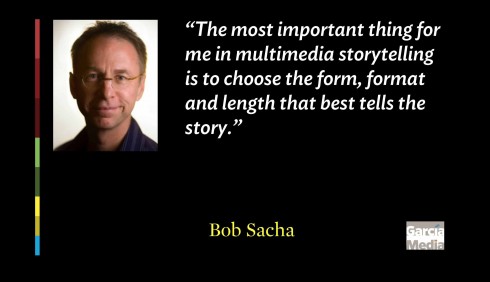
Bob Sacha is an award-winning multimedia producer, photographer, documentary filmmaker,editor and teacher. I met Bob at Syracuse University’s Newhouse School of Public Communications when I was teaching there and Bob was a a student in my graphic arts class. His name is one of about 16 that appear in the credits for The Guardian’s NSA Files: Decoded—What the revelations mean for you story. A multimedia story like this one from The Guardian is a big production requiring skills in many distinct areas.
I asked Bob, a veteran photojournalist whose credits include contributing photographer at National Geographic, LIFE, and Fortune magazines, , about working in this type of multimedia storytelling:
Like almost every other journalist, my heart is in long form. But the most important thing for me in multimedia storytelling is to chose the form, format and length that best tells the story. Everyone wants the simple rule, such as ” The only way to tell a video story online is under 2 minutes .” But sometimes 2 minutes is way too long and other times 2 minutes is too short. So dive into the story then let the storytelling dictate the format and length.
And I also asked Bob what he feels is different about being a storyteller today:
The digital era has been an amazing boom for me as a visual storyteller. I started as a photojournalist, but was thrilled by the possibilities that the web offers to tell stories in different forms. Plus the web is predominantly a visual medium. I was excited to learn new skills that helped me adapt to the way we tell stories online. And I’m crazy busy as a result of that investment.
A “new age of storytelling”
Recently, in an upbeat report about reasons to be optimistic and confident about the future of newspapers, Ken Doctor, media analyst, had this to say about storytelling:
We’re at the beginning of a new age of storytelling.From the reality and near-myth of The New York Times’ Snow Fall to content marketing and native ads, storytelling is finally taking advantage of the whole digital toolbox. There’s editorial storytelling and commercial storytelling, both built on the same tools of video and visuals, interactivity and immersiveness, voice and view. The best storytellers — and isn’t that a core of what journalism has always been about? — will be among the winners.
Watch video with part of The Guardian’s story
How story was promoted:
What the revelations mean for you.
http://www.theguardian.com/world/interactive/2013/nov/01/snowden-nsa-files-surveillance-revelations-decoded#section/1
Other multimedia storytelling examples worth studying:
Snow Fall: The Avalanche at Tunnel Creek
http://www.nytimes.com/projects/2012/snow-fall/#/?part=tunnel-creek
Tomato Can Blues: a wonderful story, spectacularly illustrated, with special effects that mesmerized;
http://www.nytimes.com/projects/2013/tomato-can-blues/
The Russia Left Behind: photo sets the scene
http://www.nytimes.com/newsgraphics/2013/10/13/russia/
Firestorm in The Guardian
http://www.theguardian.com/world/interactive/2013/may/26/firestorm-bushfire-dunalley-holmes-family
The Jockey in The New York Times
http://www.nytimes.com/projects/2013/the-jockey/?_r=0#/?chapt=introduction
Chasseurs du temps (Time keepers), L’Equipe (France)
http://www.lequipe.fr/explore/chasseurs-de-temps/#CHAP04
A Google Spreadsheet of Snowfall-type stories:
https://docs.google.com/spreadsheet/ccc?key=0AnWYxsUNHS4FdGVYMnpkdGdTNTU0RS1SXzktcnZwRWc#gid=0
Longform magazine features
http://www.spd.org/2013/10/longform-magazine-features.php
VG of Norway: Prior to Norwegian elections
http://www.vg.no/spesial/2013/valg/tegneserie/
Our previous blog posts on the subject:
Storytelling in the digital age: some essentials endure
https://garciamedia.com/blog/articles/pstorytelling_in_the_digital_age_some_essentials_endure_p
The (happy) evolution of those multimedia story packages
https://garciamedia.com/blog/articles/pthe_happy_evolution_of_those_multimedia_story_packages_p
More about Bob Sacha:
Bob Sacha website
www.bobsacha.com
Sacha: what I learned judging hundreds of multimedia stories in 2 days
http://bobsacha.com/2012/11/16/what-i-learned-judging-hundreds-of-multimedia-stories-in-2-days/
Coming Tuesday
We continue discussing and analyzing good examples of multimedia storytelling. Tuesday: a vibrant example from Norway’s Aftenposten.